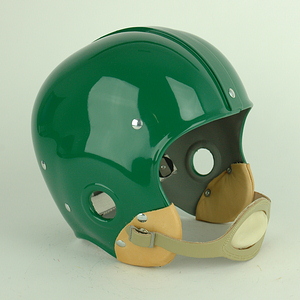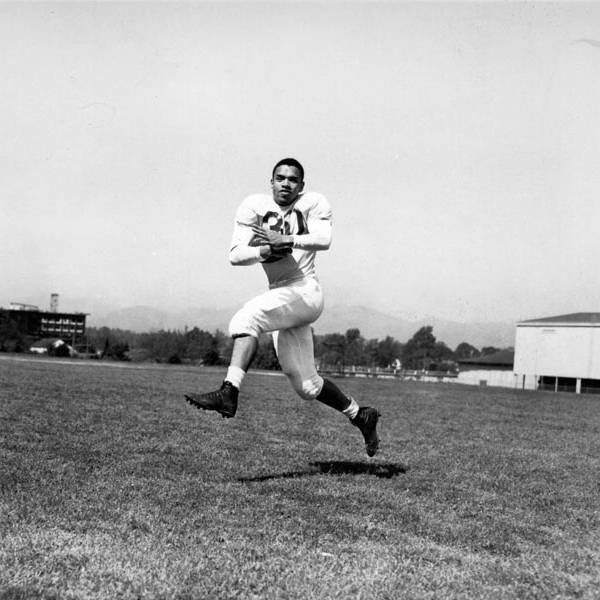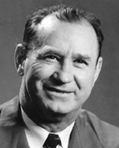The addition of Colorado to the new Pac-12 provides Oregon with a renewal of an occasional and long-dormant regular season series. The teams met twelve times between 1949 and 1987. Long-time victims of The Suffering might be surprised to learn the regular season series has been knotted at six wins each for a generation.
The last three UO-CU games, all post-1994, were post-season; these bowls are fairly well documented and, since they took place during the post-Suffering era, are not of historic interest (in the context of this blog, anyway).
But the six home-and-home series, all played in consecutive seasons, have held peculiar combinations of high drama, intensity, historic interest, tragedy, comedy and farce. With the Ducks on the cusp of renewing what has been a very competitive regular-season rivalry, we’ll take a DuckDowns look at those twelve previous contests, two at a time.
October 15, 1949 – Hayward Field –
Oregon 42, Colorado 14
 God bless HelmetHut.Colorado wasn’t much of a football power in the post-WW2 era. The Buffs had gone through three coaches in five seasons, and new head coach Dallas “Dal” Ward – a Beaver alum (1927) – came into the 1949 game looking for Colorado’s first win ever against a team from the West Coast. He left Hayward in a daze, his team shredded by the defending conference champions for 333 yards rushing on 47 carries. George Bell broke free for a 60 yard score in the first minute, Bob Sanders went around end for a 49 yard TD, John McKay had two interceptions, and after Woodley Lewis returned a 3rd quarter kickoff 102 yards, the Webfoots were never threatened, leading 35-7 ninety seconds into the 2nd half.
God bless HelmetHut.Colorado wasn’t much of a football power in the post-WW2 era. The Buffs had gone through three coaches in five seasons, and new head coach Dallas “Dal” Ward – a Beaver alum (1927) – came into the 1949 game looking for Colorado’s first win ever against a team from the West Coast. He left Hayward in a daze, his team shredded by the defending conference champions for 333 yards rushing on 47 carries. George Bell broke free for a 60 yard score in the first minute, Bob Sanders went around end for a 49 yard TD, John McKay had two interceptions, and after Woodley Lewis returned a 3rd quarter kickoff 102 yards, the Webfoots were never threatened, leading 35-7 ninety seconds into the 2nd half.
Still in the conference race at 4-1, Oregon suffered a 40-13 trouncing at the hands of USC a week later, then collapsed at Iowa, giving up 28 points in the 4th quarter in a three-point loss.
The Webfoots didn’t win another game in 1949, and that big win at Hayward Field over Colorado turned out to be the last significant victory for Jim Aiken as coach.
 Woodley Lewis, 1949 (Coburg Hills in background)Fun Fact: A member of the UO Hall of Fame, Woodley Lewis may have been the fastest Oregon player in history. A juco transfer from Los Angeles City College, Lewis was the Hoffman Award winner as team MVP in 1949. That year, Woodley set team records that still stand for kickoff return average over a season (43 ypr, nearly 10 yards longer than Jonathan Stewart in 2006), the longest kickoff return (the 102 yarder vs Colorado) and the longest punt return (92 yards vs OSC). His eight picks in ‘49 still ranks among the top five season efforts; he had three INTs against Idaho, and until someone picks off four in a game he’ll continue to be tied atop that list as well. He also lettered in track, and won the long jump at the Northern Division championships as a senior, going 26’3”.
Woodley Lewis, 1949 (Coburg Hills in background)Fun Fact: A member of the UO Hall of Fame, Woodley Lewis may have been the fastest Oregon player in history. A juco transfer from Los Angeles City College, Lewis was the Hoffman Award winner as team MVP in 1949. That year, Woodley set team records that still stand for kickoff return average over a season (43 ypr, nearly 10 yards longer than Jonathan Stewart in 2006), the longest kickoff return (the 102 yarder vs Colorado) and the longest punt return (92 yards vs OSC). His eight picks in ‘49 still ranks among the top five season efforts; he had three INTs against Idaho, and until someone picks off four in a game he’ll continue to be tied atop that list as well. He also lettered in track, and won the long jump at the Northern Division championships as a senior, going 26’3”.
Lewis went on to a ten-year NFL career with the Rams, Cardinals and Dallas, and his name is in the pro record books as well; he set a record in 1950 for interception return yardage as a rookie (and still ranks #3). He led the NFL in kickoff and punt returns and return yardage in 1953 and 1954, and was All-Pro both seasons. After his trade to Chicago, Lewis switched to offense full-time, gained over 1300 yards as a receiver in two seasons, and made All-Pro again in 1958.
Lewis’s contributions are sadly overlooked in most Duck histories. His limited career – just 18 games over two seasons – and lack of postseason honors may explain this. But his omission from the “Notable Oregon Standouts” section of the official Oregon football media guide is unconscionable. Consider that Tuffy Leemans, who never played in a varsity game for Oregon, gets a paragraph – because he’s in the NFL Hall of Fame. Lewis was as dominant at his positions as Jake Leicht was in 1945-47; Leicht gets a paragraph and photo, but Woodley is shut out, even after breaking Leicht’s interception and return records.*
After retiring from football, Lewis returned to L.A., where he owned a bowling alley, served as president of the Compton Chamber of Commerce and worked as a probation counselor. He died in 2000 at the age of 75. After his death went unmentioned in the papers, teammate Emmett Williams appeared in person at the Register-Guard office to insist that some mention be made of one of Oregon’s greatest players. Ron Bellamy obliged, publishing a fine obituary for Lewis a few weeks later. “Lewis won’t be forgotten”, the headline read, but the sad truth is that he had been.
Fun Fact: Remember the ‘95 Cotton Bowl, with the controversy surrounding a certain Colorado coach and his decision to run a fake punt with a big 4th quarter lead? In 1949, with Oregon up 35-14 late in the 4th, the Ducks lined up in punt formation from midfield; but Duck punter Jim Calderwood passed, hitting flanker Darrell Robinson in stride for a 52 yard touchdown. It is not known whether effigies of Jim Aiken were burned on the streets of Boulder following this demonstration of poor sportsmanship.
November 18, 1950 – Folsom Field –
Colorado 21, Oregon 7
The goodwill Jim Aiken had built in creating his 1948 Cotton Bowl squad around outstanding players like Norm Van Brocklin and Brad Ecklund had, by the Colorado return game in 1950, all but vanished. Oregon came to Boulder on a five game losing streak Jim Aiken, Oregon HC 1947-50, with only a win over Montana, and the vultures were circling the football offices at McArthur Court.
Jim Aiken, Oregon HC 1947-50, with only a win over Montana, and the vultures were circling the football offices at McArthur Court.
In this first appearance ever by the Webfoots at Colorado, the team came up small before a small crowd of 12,233; the lone bright spot was a then-record 82 yard touchdown pass from Hal Dunham to Tommy Edwards for Oregon’s only touchdown.
Oregon ended a miserable season by losing at OSC, 14-2, finishing 1-9. It was, and still is, the worst season record in school history.
Fun Fact: Aiken’s bad season – and his football coaching career – ended with the loss in the Civil War. A gravel-voiced, old-school coach not above whipping, cussing and ridiculing his players as a motivational factor, Aiken’s four year record (21-20) was dubbed the “riches-to-rags” career. His first two teams were built around disciplined, veteran players – literally; several starters on the Cotton Bowl team had served in WW2. And Aiken was widely praised for turning the team into a contender in two short seasons.
But once the WW2 veterans like Ecklund finally graduated, and Aiken’s team began to be dominated by his own recruits, predominately juco cast-offs rejected by the California schools and local athletes of dubious quality, it was a matter of time until Aiken’s coaching shortcomings and ethical shortcuts became untenable. Established as a tenured “professor”, Aiken’s sole undergraduate class – PE-190, only offered during summer session – was exposed in news reports as nothing more than off-season football practice for credit; the school paid a stiff fine for the violation.
At the 1951 PCC conference in Spokane, the UO was hit with a long list of code violations, all of which were attributed to Aiken’s loose and disorganized management style. The conference was rumored to be preparing to recommend to the Oregon administration that Aiken be terminated, and the school would be fined $15,000; Aiken saved them the trouble, resigning in mid-June, and gave up coaching to enter the lumber business in Roseburg. He was replaced by Len Casanova, and the rest, as they say, is history.
Next episode: 1955-1956
* (It’s a sad fact that players from the 1950s get short shrift in the “official” archives. In 1955, Dick James, Jim Shanley and Jack Morris had five 100-yard games between them, but not one is mentioned in the several sections of the media guide for which they’d qualify. Jack Morris’ astounding 212-yard game against USC in 1957, an effort that put the Ducks in the Rose Bowl and a record that stood for 14 years, wasn’t listed in the guide until I prompted Media Services to add it last year. According to the 2010 media guide, Oregon only had two backs gain over 100 yards in a game from 1949 to 1959. Yes, everybody wants to know about the current team and the recent successes – and Andy McBride’s team does a great job of this – but if they’re going to have a “history” section, you’d think they’d try to get it right.)